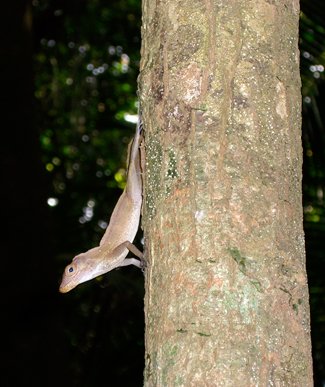Dance moves help lizards stand out in a crowd

LIZARDS HAVE EVOLVED SOME elaborate moves to communicate their messages in a visually crowded world, new Australian research has found.
Eight species of Anolis lizard found on the islands of Jamaica and Puerto Rico rely on subtle body movements, to both attract mates and ward off rivals. Each species has evolved its own way to stand out from the surrounding visual noise.
“Their tropical habitats are a constant blur of motion, from the sea-breeze moving shrubbery on the coast to the shifting dabbled light of the forest floor in the mountains,” says the lead researcher, biologist Dr Terry Ord from University of New South Wales. “All this presents a real challenge for these small, cryptically coloured guys to visually communicate.”
Male Anolis lizards strut their stuff in a variety of elaborate movements, from head-bobbing, push-ups to puffing out their dewlaps – a coloured throat pouch – to advertise their ownership of a territory, Terry says.
The scientists have discovered the lizards use two specific strategies. The Puerto Rican lizards tend to wait for the wind-blown leaves become still before performing their territorial dance. Whereas Jamaican lizards send their signals regardless of the level of visual noise, by deploying a high-speed flash of the dewlap – the coloured throat pouch, Terry says.
Robot lizards
By developing a ‘robot lizard’ to give the wild lizards an audience, Terry and colleagues were able to manipulate and monitor lizard behaviour in the field and analyse the different movements each of the observed eight species employed. It is not yet known if the other 150 identified species of Anolis lizards found in the Caribbean, use similar tactics.
The signalling language each of the studied species varies from island to island and there even appears to be regional dialects. Terry describes this as “a many to one phenomenon”, where there are multiple possible ways to come up with the same solution.
Exaggerated movements are more effective than the subtle ones, even in the animal world, Terry says. “If you were trying to capture my attention from across the road, a polite little wave may not be enough; this is why abrupt movements are such a salient attribute.”
Trade off
However, this may come at a cost – being conspicuous to rivals or prospective mates, means increased chances of being spotted by predators, especially birds.
“These guys are in a similar situation to dragon lizards in Australia, where their need to be conspicuous puts them at risk. It’s the classic scenario of being good for one thing but bad for another; the result is a compromise,” says Terry.
Dr Devi Stuart-Fox, biologist from the University of Melbourne whose research interests include dragons, agrees these displays increase the risk for attracting predators. “This is always a problem with any signal – unwanted attention from predators – but the need to signal is usually more important than the need to stay hidden,” she says.
There have been many studies of how animals communicate in the presence of interference, such as frogs competing with other species of frogs and background environmental noise, says Devi. “However, most people have studied auditory interference, whereas this study is original as it is looking at visual interference or motion noise,” she says.
The research was published recently in the journal, The American Naturalist.
VIDEO: The Anolis gundlachi uses push-ups to signal other lizards
RELATED STORIES

